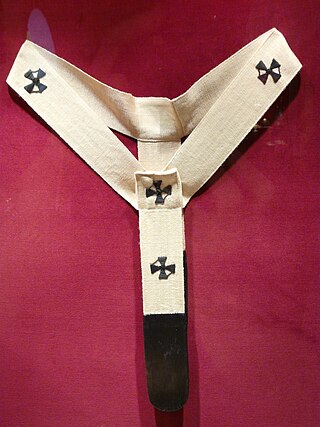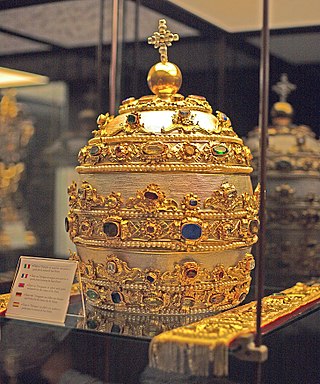The papal cross is a Christian cross, which serves as an emblem for the office of the Pope in ecclesiastical heraldry. It is depicted as a staff with three horizontal bars near the top, in diminishing order of length as the top is approached.
The papal cross is a Christian cross, which serves as an emblem for the office of the Pope in ecclesiastical heraldry. It is depicted as a staff with three horizontal bars near the top, in diminishing order of length as the top is approached.
The cross is analogous to the two-barred archiepiscopal cross used in heraldry to indicate an archbishop, and seems to have been used precisely to indicate an ecclesiastical rank still higher than that of archbishop. In the past, this design of the cross was often used in ecclesiastical heraldry as a distinctive mark of his office. It was often merely an artistic device, as use of a staff or crosier was not part of the traditional papal insignia. [1] However, at least one staff surmounted with a papal cross does exist.
Symbolism connected with the papal powers have been attached to the three crossbars, similar to the symbolism attached to the three bands on the papal tiara.

The pallium is an ecclesiastical vestment in the Catholic Church, originally peculiar to the pope, but for many centuries bestowed by the Holy See upon metropolitans and primates as a symbol of their conferred jurisdictional authorities, and still remains a papal emblem.

A crosier or crozier is a stylized staff that is a symbol of the governing office of a bishop or abbot and is carried by high-ranking prelates of Roman Catholic, Eastern Catholic, Eastern Orthodox, Oriental Orthodox, and some Anglican, Lutheran, United Methodist and Pentecostal churches.
The highest-ranking bishops in Eastern Orthodoxy, Oriental Orthodoxy, the Catholic Church, the Hussite Church, Church of the East, and some Independent Catholic Churches are termed patriarchs.

The papal tiara is a crown that was worn by popes of the Catholic Church from as early as the 8th century to the mid–20th century. It was last used by Pope Paul VI in 1963, and only at the beginning of his reign.

The mitre or miter is a type of headgear now known as the traditional, ceremonial headdress of bishops and certain abbots in traditional Christianity. Mitres are worn in the Catholic Church, Eastern Orthodox Church, Oriental Orthodox Churches, the Anglican Communion, some Lutheran churches, for important ceremonies, by the Metropolitan of the Malankara Mar Thoma Syrian Church, and also, in the Catholic Church, all cardinals, whether or not bishops, and some Eastern Orthodox archpriests.

Monsignor is an honorific form of address or title for certain members of the clergy, usually of the Roman Catholic Church. Monsignor is the apocopic form of the Italian monsignore, meaning "my lord". "Monsignor" can be abbreviated as Mons. or Msgr. In some countries, the title "monsignor" is used as a form of address for bishops. However, in English-speaking countries, the title is dropped when a priest is appointed as bishop.

A galero is a broad-brimmed hat with tasselated strings which was worn by clergy in the Catholic Church. Over the centuries, the red galero was restricted to use by individual cardinals while such other colors as black, green and violet were reserved to clergy of other ranks and styles.

In heraldry, a charge is any emblem or device occupying the field of an escutcheon (shield). That may be a geometric design or a symbolic representation of a person, animal, plant, object, building, or other device. In French blazon, the ordinaries are called pièces, and other charges are called meubles.

Papal regalia and insignia are the official items of attire and decoration proper to the Pope in his capacity as the visible head of the Catholic Church and sovereign of the Vatican City State.
Papal coats of arms are the personal coat of arms of popes of the Catholic Church. These have been a tradition since the Late Middle Ages, and has displayed his own, initially that of his family, and thus not unique to himself alone, but in some cases composed by him with symbols referring to his past or his aspirations. This personal coat of arms coexists with that of the Holy See.
The Secretariat of State is the oldest dicastery in the Roman Curia, the central papal governing bureaucracy of the Catholic Church. It is headed by the Cardinal Secretary of State and performs all the political and diplomatic functions of the Holy See. The Secretariat is divided into three sections, the Section for General Affairs, the Section for Relations with States, and, since 2017, the Section for Diplomatic Staff.

The personal papal coat of arms of Pope Benedict XVI was designed by Archbishop Andrea Cordero Lanza di Montezemolo soon after the papal election in 2005.

Portuguese heraldry encompasses the modern and historic traditions of heraldry in Portugal and the Portuguese Empire. Portuguese heraldry is part of the larger Iberian tradition of heraldry, one of the major schools of heraldic tradition, and grants coats of arms to individuals, cities, Portuguese colonies, and other institutions. Heraldry has been practiced in Portugal at least since the 12th century, however it only became standardized and popularized in the 16th century, during the reign of King Manuel I of Portugal, who created the first heraldic ordinances in the country. Like in other Iberian heraldic traditions, the use of quartering and augmentations of honor is highly representative of Portuguese heraldry, but unlike in any other Iberian traditions, the use of heraldic crests is highly popular.

Ecclesiastical heraldry refers to the use of heraldry within Christianity for dioceses, organisations and Christian clergy. Initially used to mark documents, ecclesiastical heraldry evolved as a system for identifying people and dioceses. It is most formalized within the Catholic Church, where most bishops, including the pope, have a personal coat of arms. Clergy in Anglican, Lutheran, Eastern Catholic and Eastern Orthodox churches follow similar customs, as do institutions such as schools and dioceses.

A crown is often an emblem of a sovereign state, usually a monarchy, but also used by some republics.

In the Catholic Church, a bishop is an ordained minister who holds the fullness of the sacrament of holy orders and is responsible for teaching doctrine, governing Catholics in his jurisdiction, sanctifying the world and representing the Church. Catholics trace the origins of the office of bishop to the apostles, who it is believed were endowed with a special charism and office by the Holy Spirit at Pentecost. Catholics believe this special charism and office has been transmitted through an unbroken succession of bishops by the laying on of hands in the sacrament of holy orders.

The coats of arms of the Holy See and Vatican City in the form that combines two crossed keys and a tiara used as a coat of arms of the Holy See have origins attested from the 14th century. The combination of one gold and one silver key is a somewhat later development.

In heraldic achievements, the helmet or helm is situated above the shield and bears the torse and crest. The style of helmet displayed varies according to rank and social status, and these styles developed over time, in step with the development of actual military helmets. In some traditions, especially German and Nordic heraldry, two or three helmets may be used in a single achievement of arms, each representing a fief to which the bearer has a right. For this reason, the helmets and crests in German and Nordic arms are considered essential to the coat of arms and are never separated from it.

The papal ferula is the pastoral staff used in the Catholic Church by the pope. It is a rod with a knob on top surmounted by a cross. It differs from a crosier, the staff carried by other Latin Church bishops, which is curved or bent at the top in the style of a shepherd's crook.

The Christian cross, with or without a figure of Christ included, is the main religious symbol of Christianity. A cross with a figure of Christ affixed to it is termed a crucifix and the figure is often referred to as the corpus.